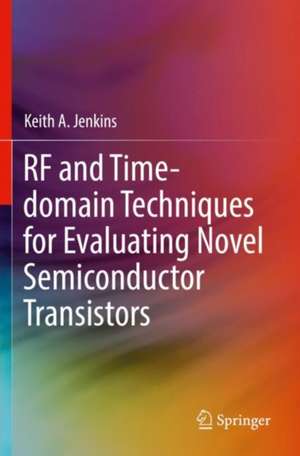RF and Time-domain Techniques for Evaluating Novel Semiconductor Transistors
Autor Keith A. Jenkinsen Limba Engleză Paperback – 17 dec 2022
| Toate formatele și edițiile | Preț | Express |
|---|---|---|
| Paperback (1) | 481.20 lei 6-8 săpt. | |
| Springer International Publishing – 17 dec 2022 | 481.20 lei 6-8 săpt. | |
| Hardback (1) | 584.43 lei 6-8 săpt. | |
| Springer International Publishing – 16 dec 2021 | 584.43 lei 6-8 săpt. |
Preț: 481.20 lei
Nou
Puncte Express: 722
Preț estimativ în valută:
92.09€ • 95.60$ • 76.79£
92.09€ • 95.60$ • 76.79£
Carte tipărită la comandă
Livrare economică 22 martie-05 aprilie
Preluare comenzi: 021 569.72.76
Specificații
ISBN-13: 9783030777777
ISBN-10: 3030777774
Pagini: 168
Ilustrații: XI, 168 p. 128 illus., 87 illus. in color.
Dimensiuni: 155 x 235 mm
Greutate: 0.26 kg
Ediția:1st ed. 2022
Editura: Springer International Publishing
Colecția Springer
Locul publicării:Cham, Switzerland
ISBN-10: 3030777774
Pagini: 168
Ilustrații: XI, 168 p. 128 illus., 87 illus. in color.
Dimensiuni: 155 x 235 mm
Greutate: 0.26 kg
Ediția:1st ed. 2022
Editura: Springer International Publishing
Colecția Springer
Locul publicării:Cham, Switzerland
Cuprins
Introduction.- Signal propagation & connection to devices.- Frequency characterization of devices.- Spectral analysis techniques.- Device propagation delay.- Jitter measurement.- Transient and time-dependent phenomena.
Notă biografică
Keith A. Jenkins was a Research Staff Member at the IBM Thomas J. Watson Research Center from 1983 to 2018. In this position, he had the privilege of working with device development, technology evaluation, and circuit design, leading to research in a large variety of device and circuit subjects. These include high frequency measurement techniques, electron beam circuit testing, radiation-device interactions, low temperature electronics, SOI technology, substrate crosstalk in circuits, frequency response of nanoscale devices and studying the impact of self-heating in advanced CMOS technologies. He also worked to design circuits for analog on-chip self-measurement, including jitter and phase error measurement, and on-product reliability monitoring. He designed several compact and efficient structures to measure device performance, uniformity and device reliability, in order to replace the discrete transistor structures usually used for these studies.
In pursuing these research goals, he developed many new measurement techniques, some of which are covered in this book. He received several technical awards from IBM, and several best paper awards from conferences and journals.
He received a PhD in physics from Columbia University for experimental work in high energy physics, and before joining IBM, he worked in high energy physics at The Rockefeller University. He was an adjunct professor of physics at Hunter College and Manhattan College.
Dr. Jenkins is now engaged as a consultant on the subject of semiconductor device and circuit measurements.
In pursuing these research goals, he developed many new measurement techniques, some of which are covered in this book. He received several technical awards from IBM, and several best paper awards from conferences and journals.
He received a PhD in physics from Columbia University for experimental work in high energy physics, and before joining IBM, he worked in high energy physics at The Rockefeller University. He was an adjunct professor of physics at Hunter College and Manhattan College.
Dr. Jenkins is now engaged as a consultant on the subject of semiconductor device and circuit measurements.
Textul de pe ultima copertă
This book presents a variety of techniques using high-frequency (RF) and time-domain measurements to understand the electrical performance of novel, modern transistors made of materials such as graphene, carbon nanotubes, and silicon-on-insulator, and using new transistor structures. The author explains how to use conventional RF and time- domain measurements to characterize the performance of the transistors. In addition, he explains how novel transistors may be subject to effects such as self-heating, period-dependent output, non-linearity, susceptibility to short-term degradation, DC-invisible structural defects, and a different response to DC and transient inputs. Readers will understand that in order to fully understand and characterize the behavior of a novel transistor, there is an arsenal of dynamic techniques available. In addition to abstract concepts, the reader will learn of practical tips required to achieve meaningful measurements, and will understand the relationship between these measurements and traditional, conventional DC characteristics.
Caracteristici
Describes an arsenal of dynamic, RF and time-domain techniques to understand and characterize the behavior of novel transistors made of graphene, carbon nanotubes and silicon-on-insulator, and using new transistor structrures Explains the importance of using RF and time-domain measurements and the relationship of such measurement results to DC transistor characteristics Covers practical aspects of using the measurement techniques described Discusses the inter-relationship of the various methods presented
